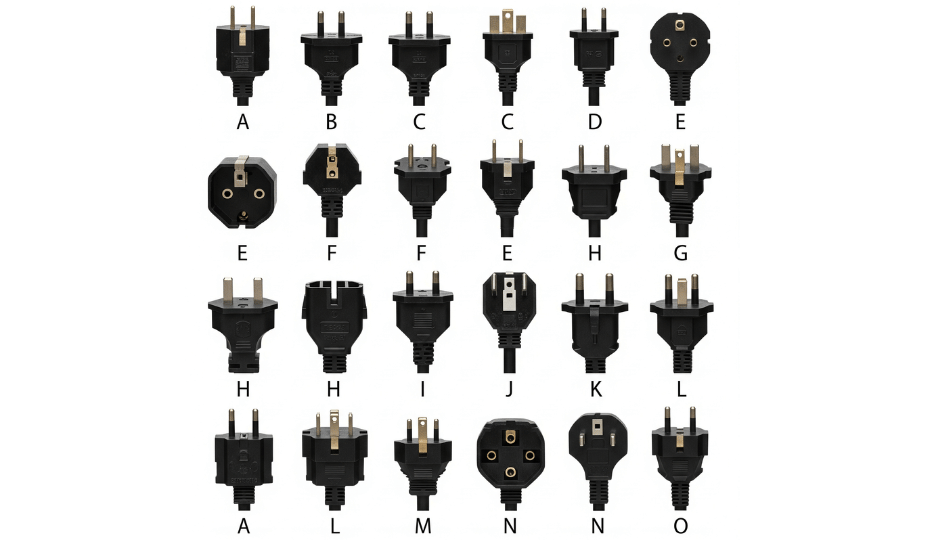Power plug standards vary significantly across different regions, reflecting differences in shape, size, voltage, frequency, and grounding methods. These variations are influenced by local voltage standards, historical developments, and safety regulations. Here’s a comprehensive overview of the main differences in power plug standards across various regions:
1. North America (USA, Canada, Mexico)
- Plug Types: Type A and Type B
- Type A: Two flat parallel prongs.
- Type B: Two flat parallel prongs and a round grounding pin.
- Voltage: 110-120V
- Frequency: 60Hz
- Characteristics: These plugs are widely used in North America, with Type B providing added safety through grounding. Both types are commonly found in the USA, Canada, and Mexico.
2. Continental Europe (EU Countries)
- Plug Types: Type C (Europlug), Type E, and Type F
- Type C: Two round pins, common across most European countries.
- Type E: Two round pins with an earth grounding pin, used in France, Belgium, Italy, etc.
- Type F: Two round pins similar to Type C, but with grounding clips on the sides, used in Germany, Austria, etc.
- Voltage: 220-240V
- Frequency: 50Hz
- Characteristics: Type C (Europlug) is a versatile plug used across many European countries for low-power devices. Type E and F plugs offer grounding for enhanced safety, with slight variations depending on the country.
3. United Kingdom and Ireland
- Plug Type: Type G
- Type G: Three rectangular prongs, with one prong serving as an earth grounding pin.
- Voltage: 230V
- Frequency: 50Hz
- Characteristics: The Type G plug is known for its robust safety features, including an integrated fuse. It is widely used in the UK, Ireland, and other regions that follow British standards, such as Hong Kong and Singapore.
4. Mainland China
- Plug Types: Type A and Type C
- Type A: Similar to the North American Type A.
- Type C: Similar to the European Type C.
- Voltage: 220V
- Frequency: 50Hz
- Characteristics: In China, both Type A and Type C plugs are used, with the Type A plug being more common for older appliances and Type C for newer devices. The Type I plug (three-prong, similar to Australia) is also used for some appliances.
5. Australia and New Zealand
- Plug Type: Type I
- Type I: Two flat parallel prongs and an earth grounding pin, arranged in an inverted V-shape.
- Voltage: 230-240V
- Frequency: 50Hz
- Characteristics: The Type I plug is distinctive with its unique prong arrangement, used in both Australia and New Zealand. It is similar to the Chinese standard but has specific polarity requirements, ensuring it cannot be inserted in reverse.
6. Japan
- Plug Types: Type A and Type B
- Type A: Two flat parallel prongs.
- Type B: Two flat parallel prongs and a round grounding pin (less common).
- Voltage: 100V
- Frequency: 50Hz or 60Hz (depending on the region)
- Characteristics: Japan’s plugs are similar to those in North America, with Type A being the most common. The key difference is Japan’s lower voltage of 100V. The frequency also varies: 50Hz in the eastern part of Japan and 60Hz in the western part.
7. South Africa
- Plug Type: Type M
- Type M: Three large round pins, with one used for grounding.
- Voltage: 230V
- Frequency: 50Hz
- Characteristics: The Type M plug is a legacy standard with larger and thicker prongs, similar to the UK’s old BS 546 standard. It is still in use in South Africa and a few other countries.
8. Italy
- Plug Type: Type C and Type L
- Type C: Two round pins (Europlug).
- Type L: Three round pins, unique to Italy, with two versions for 10A and 16A.
- Voltage: 230V
- Frequency: 50Hz
- Characteristics: Italy’s Type L plug is unique, offering both two-prong and three-prong versions. The prongs are typically thinner, making the plug more compact and specific to Italian standards.
9. Brazil
- Plug Type: Type N
- Type N: Two round pins with an earth grounding pin.
- Voltage: 110-220V
- Frequency: 60Hz
- Characteristics: Brazil uses the Type N plug, which is designed for compatibility with European standards but adapted to the local voltage, which can vary between 110V and 220V.

The differences in power plug standards across various regions reflect local electrical requirements and historical influences. Understanding these differences is crucial for safe and effective use of electrical devices, especially when traveling or using devices in different countries. When necessary, plug adapters or power cords tailored to the local standard can be used to ensure compatibility. Always check the voltage and frequency compatibility of your devices with the region’s power supply before use.









